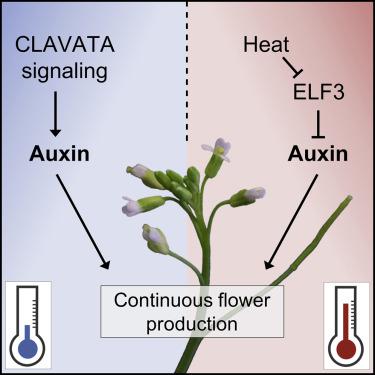Current Biology ( IF 8.1 ) Pub Date : 2020-11-05 , DOI: 10.1016/j.cub.2020.10.008 Daniel S Jones 1 , Amala John 1 , Kylie R VanDerMolen 1 , Zachary L Nimchuk 2

|
The ability to thrive in diverse environments requires that species maintain development and reproduction despite dynamic conditions. Many developmental processes are stabilized through robust signaling pathways that cooperatively ensure proper development.1 During reproduction, plants like Arabidopsis thaliana continuously generate flowers on growing indeterminate inflorescences.2 Flower primordia initiation and outgrowth depends on the hormone auxin and is robust across diverse environments.3, 4, 5, 6 Here, we show that reproductive development under different thermal conditions requires the integration of multiple pathways regulating auxin-dependent flower production. In colder/ambient temperatures, the receptor complex CLAVATA2/CORYNE (CLV2/CRN) is necessary for continuous flower outgrowth during inflorescence development. CLV2/CRN signaling is independent of CLAVATA1 (CLV1)-related receptor signaling but involves the CLAVATA3 INSENSITIVE RECEPTOR KINASE (CIK) family co-receptors, with higher order cik mutant combinations phenocopying clv2/crn flower outgrowth defects. Developing crn inflorescences display reduced auxin signaling, and restoration of auxin biosynthesis is sufficient to restore flower outgrowth in colder and ambient temperatures. In contrast, at higher temperatures, both clv2/crn signaling and heat-induced auxin biosynthesis via YUCCA family genes are synergistically required to maintain flower development. Our work reveals a novel mechanism integrating peptide hormone and auxin signaling in the regulation of flower development across diverse thermal environments.
中文翻译:

CLAVATA Signaling 确保植物在热环境中的生殖发育
在不同环境中茁壮成长的能力要求物种在动态条件下保持发育和繁殖。许多发育过程通过强大的信号通路稳定下来,共同确保适当的发育。1在繁殖过程中,拟南芥等植物在生长不确定的花序上不断地开花。2花原基的起始和生长取决于激素生长素,并且在不同的环境中都很稳定。3, 4, 5, 6 在这里,我们表明不同热条件下的生殖发育需要整合多种途径来调节依赖生长素的花卉生产。在较冷/环境温度下,受体复合物 CLAVATA2/CORYNE (CLV2/CRN) 是花序发育过程中花朵连续生长所必需的。CLV2/CRN 信号传导独立于 CLAVATA1 (CLV1) 相关受体信号传导,但涉及 CLAVATA3 不敏感受体激酶 (CIK) 家族共受体,具有更高阶的cik突变组合表型复制clv2/crn花生长缺陷。开发crn花序显示生长素信号减少,生长素生物合成的恢复足以在较冷和环境温度下恢复花的生长。相反,在较高温度下,通过YUCCA家族基因的clv2/crn信号传导和热诱导的生长素生物合成是维持花发育所必需的。我们的工作揭示了一种整合肽激素和生长素信号传导在不同热环境中调控花卉发育的新机制。











































 京公网安备 11010802027423号
京公网安备 11010802027423号